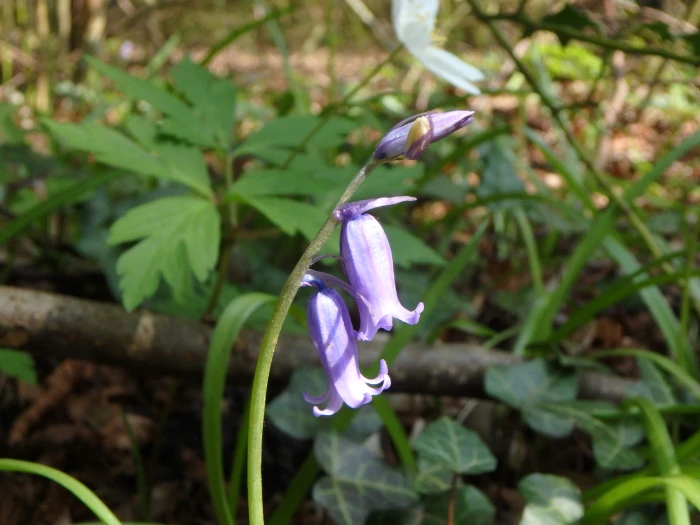Common Bluebell
(Hyacinthoides non-scripta)
Common Bluebell (Hyacinthoides non-scripta)
/
/

Daniel Cahen
CC BY 4.0
Image By:
Daniel Cahen
Recorded By:
Copyright:
CC BY 4.0
Copyright Notice:
Photo by: Daniel Cahen | License Type: CC BY 4.0 | License URL: http://creativecommons.org/licenses/by/4.0/ | Rights Holder: Daniel Cahen | Publisher: iNaturalist | Date Created: 2018-04-14T13:44-07:00 |























































Estimated Native Range
Climate Requirements for Logan, Utah
| This Plant | Your Site | Plant Suitability for Your Location | ||
|---|---|---|---|---|
| • Precipitation | 14" - 126" | 19" | Your precipitation may be insufficient for this plant. Irrigate N" / year. | Irrigate N" / year |
| • High Temp. | 53°F - 101°F | 89°F | Your summer temperatures are normal for this plant. | Excellent |
| • Low Temp. | 7°F - 50°F | 14°F | Your winter temperatures are normal for this plant | Excellent |
This plant should grow well at your location with about N inches per year (Y minutes per month) of irrigation.
Summary
Hyacinthoides non-scripta, commonly known as Common Bluebell, is a deciduous perennial herb that thrives in a variety of habitats including deciduous woodlands, meadows, and along forest edges in Western Europe. It is particularly associated with ancient woodland habitats. The plant typically grows from a bulb and reaches a height of 10-12 inches (25-30 cm). In the spring, usually from April to May, it produces a nodding, one-sided inflorescence of 5–12 tubular, sweet-scented violet–blue flowers. Each flower has six strongly recurved tepals, creating a distinctive bell shape. The plant also has 3–6 long, linear, basal leaves that are a vibrant green.
The Common Bluebell is celebrated for its enchanting blue-violet blooms that form impressive carpets of color in the spring, making it a favorite for woodland gardens and shaded borders. It is also valued for its sweet fragrance and ability to attract pollinators such as bees. In cultivation, Bluebells prefer partial shade but can tolerate full sun if the soil remains moist. They require well-drained soil and can be left undisturbed to naturalize over time. Bluebells are relatively low maintenance and are resistant to most pests and diseases. However, they can hybridize with non-native bluebell species, which can dilute the genetic distinctiveness of the native populations.CC BY-SA 4.0
The Common Bluebell is celebrated for its enchanting blue-violet blooms that form impressive carpets of color in the spring, making it a favorite for woodland gardens and shaded borders. It is also valued for its sweet fragrance and ability to attract pollinators such as bees. In cultivation, Bluebells prefer partial shade but can tolerate full sun if the soil remains moist. They require well-drained soil and can be left undisturbed to naturalize over time. Bluebells are relatively low maintenance and are resistant to most pests and diseases. However, they can hybridize with non-native bluebell species, which can dilute the genetic distinctiveness of the native populations.CC BY-SA 4.0
Plant Description
- Plant Type: Herb
- Height: 1-1.5 feet
- Width: 0.3-0.5 feet
- Growth Rate: Moderate
- Flower Color: Blue, Purple, White
- Flowering Season: Spring
- Leaf Retention: Deciduous
Growth Requirements
- Sun: Full Sun, Part Shade
- Water: Medium
- Drainage: Medium
Common Uses
Bank Stabilization, Bee Garden, Deer Resistant, Fragrant, Low Maintenance, Rabbit Resistant, Showy Flowers
Natural Habitat
Deciduous woodlands, meadows, and forest edges in Western Europe
Other Names
Common Names: English Bluebell, Wood-Hyacinth, Bluebell, Harebell, Almindelig Klokkeskilla, Klokke-Skilla, Hasenglöckchen, Atlantisches Hasenglöckchen, Klokkeblåstjerne, Wilde Hyacint, Engelsk Klockhyacint
Scientific Names: Hyacinthoides non-scripta, Agraphis nutans, Scilla non-scripta, Scilla nutans, Endymion non-scriptus, Hyacinthoides non-scripta subsp. non-scripta, Endymion nutans, Hyacinthus non-scriptus, Scilla cernua
GBIF Accepted Name: Hyacinthoides non-scripta (L.) Chouard ex Rothm.